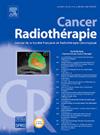Patterns of relapse after postoperative radiotherapy in patients with oral cavity cancer and a flap
IF 1.4
4区 医学
Q4 ONCOLOGY
引用次数: 0
Abstract
Purpose
Reconstructive surgery with a flap is standard practice in advanced oral cavity squamous cell carcinoma to restore essential functions. However, these functions may be compromised by postoperative radiotherapy. This study evaluates relapse patterns and treatment-related toxicity in these patients.
Methods and materials
A multicentre 2018–2023 study included 247 patients with oral cavity squamous cell carcinoma. Uni- and multivariate analyses estimated the cumulative incidence of locoregional failures, survival rates, and prognostic factors.
Results
Among the patients, 74.0 % had pT3-4 tumours, 78.5 % had free flaps, regional pedicled flaps (12.6 %), or local flaps (8.5 %). Flaps were not delineated on planning CTs. Median follow-up for living patient was 36.8 months. Fifty-eight patients (23.0 %) had involved soft-tissue margins; no correlation was found between margin involvement, stage, or flap type. Forty patients experienced local relapse within a median of 8.23 months. Local relapse rates were higher in patients with involved (28.6 %) versus clear margins (9.3 %, P < 0.004). Two-year locoregional relapse and survival rates were 17.8 %, and 74.3 %, respectively. Performance status greater than 1, locoregional relapse, and distant relapse were associated with poorer survival. Coregistration of planning-relapse CTs is challenging due to flap changes, limiting relapse pattern analysis. Subgroup analysis of locoregional relapses (14 out of 53) at the main contributing centre revealed that five relapses occurred at the native tissue-flap junction, with minor flap involvement in two cases and no intraflap failure. All other relapses occurred outside the flap.
Conclusions
Involved margin rates correlating with increased local relapse risk and were not different according flap type. Further investigation into flap segmentation and planning optimization is needed. The OPTIFLAP trial (NCT06798922, PHRC2024) aims to determine whether radiotherapy can be optimized to spare flaps without increasing the risk of locoregional failure.
口腔癌和皮瓣术后放疗后复发的模式
目的:重建皮瓣是晚期口腔鳞状细胞癌修复口腔基本功能的标准方法。然而,这些功能可能会因术后放疗而受损。本研究评估了这些患者的复发模式和治疗相关的毒性。方法与材料一项2018-2023年的多中心研究纳入247例口腔鳞状细胞癌患者。单因素和多因素分析估计了局部区域失败的累积发生率、生存率和预后因素。结果pT3-4肿瘤占74.0%,游离皮瓣占78.5%,局部带蒂皮瓣占12.6%,局部皮瓣占8.5%。皮瓣未在计划ct上划定。在世患者中位随访时间为36.8个月。58例(23.0%)患者累及软组织边缘;没有发现缘受累、分期或皮瓣类型之间的相关性。40例患者在8.23个月内出现局部复发。受累患者的局部复发率(28.6%)高于明显边缘患者(9.3%,P <;0.004)。两年局部复发率和生存率分别为17.8%和74.3%。表现状态大于1、局部复发和远处复发与较差的生存相关。由于皮瓣改变,计划复发ct的共登记具有挑战性,限制了复发模式的分析。在主要贡献中心的局部复发亚组分析(53例中有14例)显示,5例复发发生在原生组织-皮瓣交界处,2例轻微皮瓣受累,无皮瓣内衰竭。所有其他复发发生在皮瓣外。结论受累边缘率与局部复发风险增加相关,且不同皮瓣类型无差异。皮瓣分割和规划优化有待进一步研究。OPTIFLAP试验(NCT06798922, PHRC2024)旨在确定是否可以在不增加局部区域失败风险的情况下优化放疗以保留皮瓣。
本文章由计算机程序翻译,如有差异,请以英文原文为准。
求助全文
约1分钟内获得全文
求助全文
来源期刊

Cancer Radiotherapie
医学-核医学
CiteScore
2.20
自引率
23.10%
发文量
129
审稿时长
63 days
期刊介绍:
Cancer/radiothérapie se veut d''abord et avant tout un organe francophone de publication des travaux de recherche en radiothérapie. La revue a pour objectif de diffuser les informations majeures sur les travaux de recherche en cancérologie et tout ce qui touche de près ou de loin au traitement du cancer par les radiations : technologie, radiophysique, radiobiologie et radiothérapie clinique.
 求助内容:
求助内容: 应助结果提醒方式:
应助结果提醒方式:


